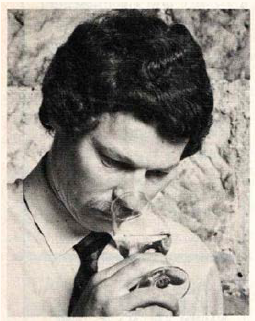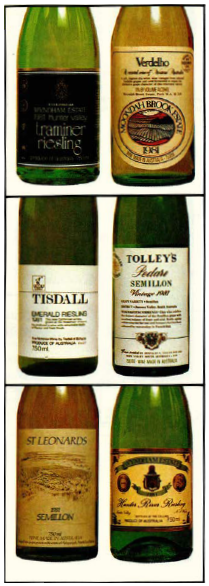By Gary Baldwin AM
Director & Principal Consultant, Wine Network Consulting, email: gbaldwin@winenet.com.au
Published in Australian & New Zealand Grapegrower & Winemaker, September 2023 – Issue 716
The wine industry begins to think outside the (bag-in) box
With many years of experience in senior winemaking and management roles within the Australian wine sector, Gary Baldwin AM, looks back on a pivitol decade in the development of the local industry – the1980s.

As part of the celebration of 60 years of publication of the Grapegrower & Winemaker, I’ve been asked to comment on the state of the Australian wine industry in the 1980s.
Now I was somewhat taken aback, as that was a very long time ago, but it now seems I will have to admit that I was there at the time.
In fact, my first job in the wine industry was in 1977 in the Hunter Valley, having enrolled a few years earlier in the first intake of the Riverina College of Advanced Education, Wine Science course under the tutelage of Brian Croser and the late Tony Jordan.
This eminent institution has long since been re-badged as Charles Sturt University.
I left the Hunter in 1984 to be exact to commence work at the Australian Wine Research Institute (AWRI) as manager of the Extension Group.
And as it turns out I actually wrote a series of pieces on winemaking for this journal from the late eighties and into the 90’s.
What was popular in the 1980s?
To understand the ‘80s we need some perspective on the previous decade which had been all about the expansion of the industry with massive plantings of Shiraz and Cabernet sauvignon in particular.
These new plantings tended to be in Hunter valley, especially the Upper Hunter as well as places like Mudgee, the Limestone Coast in South Australia and parts of Victoria.
By the late seventies things were changing, there was now a glut of red wine from all these new these new plantings and white wine was now the flavour-of-the-month.

This was well reflected in the pages of The Wine and Spirit Buying Guide, December 1981, which published the retail prices of some well-known new release wines at the time:
- Bowen Estate Coonawarra Cabernet Sauvignon $5.40
- Cullens Margaret River Cabernet Merlot Malbec $6.00
- Lindeman’s Hunter River White Burgundy Bin 3670 1969 $12.00 (Semillon, of course)
- Lindeman’s Watervale Riesling Bin 4295 1972 $17.50
- Tollana Rose $3.50
- Wyndham Estate Traminer Riesling $2.99 (advertised in the magazine as a special)
I happened to be judging classes of white wine for the magazine in 1981 with some other winemakers at that time (see photo).
Cask wine was king
The bottled wine of choice was Lindeman’s Ben Ean Moselle with supporting acts like McGuigan Traminer-Riesling and other similar semi-sweet and fruity styles.
But cask wine was really king. That is, the bag-in-box type cask which was usually but not always, 4.5 litres. (Why that volume? From the early ‘70s to early ‘80s Australia was changing from Imperial measurement to Metric and an Imperial gallon was a little over 4.5 litres). At one stage during the eighties I can recall that cask wine sales made up over 66% of Australian wine retail sales volume.
I had a front row seat in this trade in January 1979.
A cask of Moselle or Riesling (that is, sweet or dry white) – was selling for $3.99 in a retail bottle shop. At the winery I was working in at the time, my internal costings revealed it was costing us $3.89 to make the finished product at the winery.
The cask then had to be freighted to Sydney, Melbourne or wherever and the distributor and retailer both wanted to make a margin – we were losing money hand over fist.
In that vintage, 1979, our winery crushed 4500 tonnes of fruit of which 75% was red varieties but almost all of was turned into white wine by de-colouring the juice.
It is a little frightening to see something similar happening again in 2023.
We made changes in late 1979 and chainsawed around 200 hectares of Shiraz to put them out of production and stopped making cask wines; the Hunter Valley could not compete in that market.
So, it is fair to say that times were tough in the industry.
In fact things were so bad in the industry in 1985 that the South Australian government funded a vine pull scheme.
They offered growers $3000 per hectare to remove vines, which made it an easy decision for many growers where normal incomes were often around $1000 per hectare or less if in fact they could find a buyer.
Consequently, many vines were removed.
One of South Australia’s leading viticulturists, Di Davidson said, “‘81–‘85 would have to be the really low point for the production side of the industry”.
A cyclical industry
It has been well documented that boom and bust cycles in the wine industry have been commonplace. Anderson defines five cycles in the industry since 1854. The ‘80s decade covers the end of the 4th cycle from 1968 to 1987. Both he and Ruthven postulate that booms generally start after a plateau or slump. The start of the 5th boom was in 1987.
They both suggest the recovery may have commenced in 1987 but the signs were there earlier around the turn of the decade when new vineyards were being planted in cooler climate areas in Tasmania, Margaret River, Yarra Valley and other places as new operators surged into the wine industry.
The French industry even started to take notice of Australia as Moet et Chandon commenced building a winery in the Yarra Valley in 1985, Domaine Chandon.
These new pioneers were focusing on premium wines with Chardonnay and Cabernet Sauvignon being the most popular although Pinot Noir had started to become popular as well. Particularly, following a visit by the French Viticulturist Raymond Bernard in 1982.
Even established vineyards were making changes; in McLaren Vale the Johnstone family at Pirramimma removed 13 hectares of Shiraz and planted Riesling; that was clearly what the market was demanding.
Chardonnay
The ‘80s established Chardonnay as a serious wine in this country. Tyrrell’s lead the way initially but was quickly followed by Rosemount with other producers following suite as fast as they could plant.
No one had enough Chardonnay in the ground to satisfy the demand.
By the mid-‘80s Rosemount Chardonnay was quickly establishing itself as the wine of choice in the London market.
Since the surge in the ‘80s the variety has grown from strength to strength in Australia and it is clearly the number one white wine variety now.
Research and development
On research and development there were changes afoot as well in the 1980s.
In the early ‘80s the Australian Wine Research Institute appointed a new director, Dr Terry Lee from the University of new South Wales, who modernised and expanded the Institute to better service the demands of the growing industry. I was fortunate to be involved in that growth at the Institute from 1984 to 1988.
Around the same time the wine industry was starting to become more organized politically and industry funds were diverted to the CSIRO, which had previously only worked on table grapes and dried grapes. This lead to a pilot winery being built and operated at CSIRO Merbein and eventually to the establishment of the Australian Council of Viticulture. This council had representation from CSIRO, state departments of agriculture and from the two Universities teaching Oenology.
In the late ‘80s the wine industry in Australia leapt into the 5th phase of development as described by Anderson and Ruthven and commenced to take on the world. Research and development was a very important part of the growth in the industry.
By the end of the ‘80s the wine industry was in growth phase again with Rosemount Chardonnay and Jacobs Creek red wine leading the export charge. The ‘90s planting boom was about take off and the cycle continues.
References
Anderson, K., Growth and Cycles Australia’s Wine Industry, University of Adelaide Press, 2015
Ruthven, P., Good Times Ahead? The next Decade; Proceedings Fourteenth Australian Wine Industry Technical Conference, 2010
Allen, M., The History of Australian Wine. Victory Books, MUPL, 2012